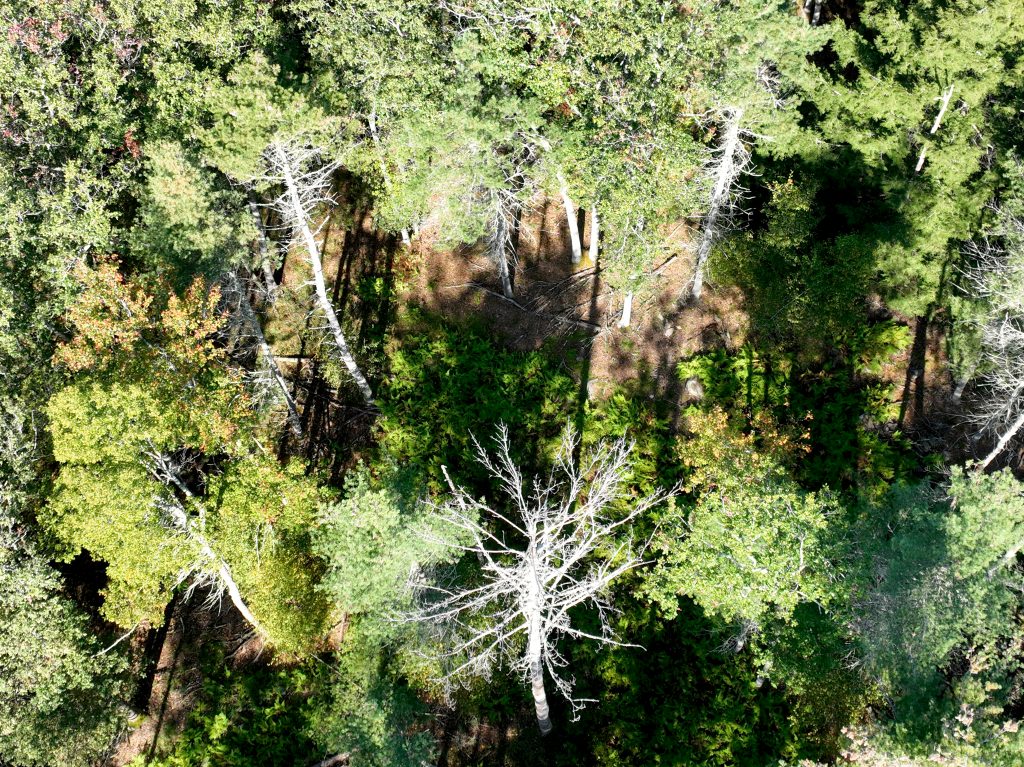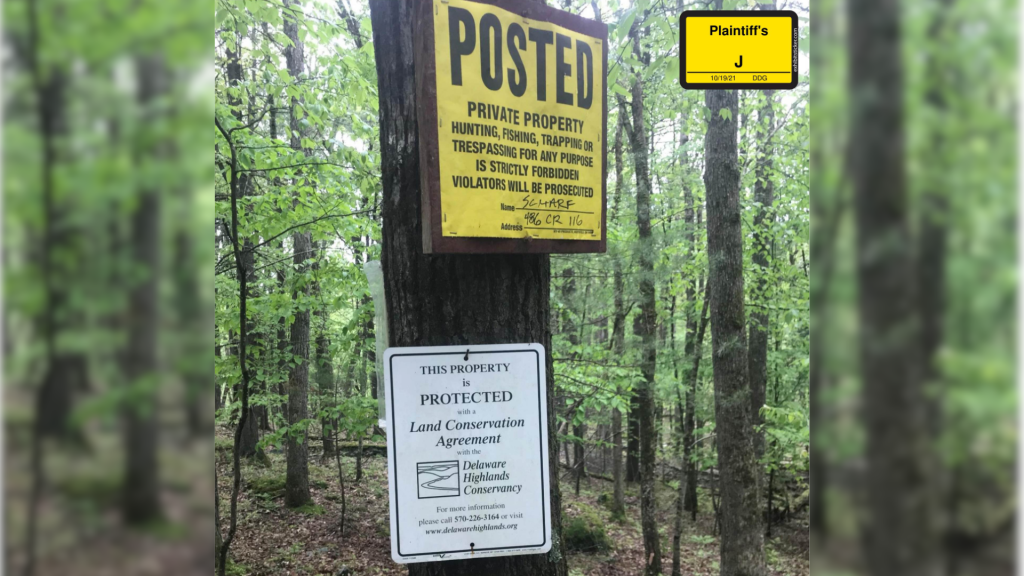
Timber theft in Upper Delaware leaves owner bereft and forestland damaged
| October 12, 2023
On Easter Sunday 2019, Helen Beichel traveled with a friend to visit forested land she owns in Sullivan County in New York.
The temperatures that day reached into the high 50s — a stark contrast to the temperatures that had been consistently in the 30s the month before. Beichel, who lives in Brooklyn, had not visited the property at all during the winter and now spring weather was finally upon the Catskills.
But the pleasant stroll through the woods she was expecting was overtaken by a sight so overwhelming and disturbing that Beichel said she nearly passed out.
One-hundred-twenty mature trees had been illegally removed from her property, which is in the Upper Delaware River watershed and so ecologically sensitive that it has a conservation easement on it protecting it from development.
The damage was not limited to just the loss of the trees: A skid trail had been created to remove the timber and heavy equipment had churned up the soil and left deep mud-filled ruts. Layers of topsoil were lost after being loosened, followed by heavy rains.
“I went up there and I was like, ‘What the heck?’” Beichel said in an interview. “I almost fainted I was in such shock.”
When she reported the theft to the State Department of Environmental Conservation, she met with an environmental conservation officer and they walked a section of her property she had not visited earlier.
“It was even worse than I thought,” she said.
The timber theft, which happened in the Town of Cochecton, bordering the Delaware River, was not a case of clear-cutting but rather of selective removal of particular high-quality, furniture-grade ashes, white oaks and hardwoods, most of them 50 to 75 years old, Beichel said.
That Easter Sunday was the start of a four-year odyssey that led to criminal charges against the logger, a civil lawsuit against adjoining property owners and a recent settlement of the suit.
Though some legal elements of the timber theft have been resolved, the ecological and psychic harms done may never be, she said.
“It will never be the way it was before,” Beichel said. “The truth of the matter is, we don’t really know the end result of this.”
Timber theft: Not uncommon but infrequent
Data about how often timber theft occurs in New York were not immediately available.
Such cases were once “surprisingly common” in New York State, dating back to the 1980s and earlier, said Mike Federice, assistant forest properties manager at SUNY College of Environmental Science and Forestry in Syracuse.
He added, though, that based on anecdotal evidence from experienced foresters and loggers, such occurrences are not as frequent today.
Cases of such thefts can go un- or underreported given that they might not be noticed until years after the trees have been illegally removed, he said. That often is the case because of the remote areas where the thefts occur and especially in cases involving absentee landowners, he said.

Ecological harms
Among other ecological harms, timber theft can damage wildlife habitat, water resources and scenic vistas.
“Ecologically, one cannot easily replace 120 mature white oaks, given their importance to wildlife as an acorn producer and more,” said Stacy McNulty, associate director of research at the Newcomb, N.Y., campus of SUNY College of Environmental Science and Forestry.
Court papers said the loss of the trees and the creation of the skid road contributed to the diversion of sediment and other runoff. That’s of note given that Mitchell Pond Brook crosses part of the property. The brook is a primary tributary to the Delaware River, which serves as a source of drinking water for more than 14 million people.
Court papers said that the coniferous and deciduous forests on the property provided habitat for diverse wildlife that include endangered or threatened species and species identified as of “special concern” in New York, including the Red-shouldered Hawk, Whip-poor-will, Red-headed Woodpecker and Cerulean Warbler.
A victim’s impact statement filed with the lawsuit cited a forester hired to assess the damage who concluded that “the ecosystem of this property was negatively altered and that the ecosystem services have been impaired in such a way that natural recovery will not occur during the next century without cultural intervention.”
Prior owner championed protection
Beichel’s property of approximately 23 acres was previously owned by Thomas Raleigh, who recognized the ecological value of the property and sought ways to protect it from development.
Raleigh died but his niece donated the land in 2009 to the Delaware Highlands Conservancy, which placed a conservation easement on it in 2012. Beichel, in turn, bought the property from the conservancy but with the protective easement still in place.
A permanent memorial created to honor Raleigh — a stone and spruce tree protected from deer by fencing — was crushed by heavy machinery used during the timber theft, according to the victim’s impact statement.
“When Ms. Beichel would walk in the forest property, she would greet Tom as she walked by his memorial,” the statement said. “Ms. Beichel was shocked to discover the destruction of the memorial and she does not understand why a person would have gone into such a delineated area.”
Beyond the scars to the land, timber theft can leave psychological scars as well, Federice said. He said the loss can have “a huge personal impact on those with any sort of attachment to their land.”
Criminal charges and a lawsuit
Beichel said she was not sure how long the logging took place before she discovered it but estimated that it had been going on for “quite some time.”
The theft, estimated to be worth $43,548, according to a DEC news release, led to charges of felony grand larceny and misdemeanor timber theft against the logger, Richard W. Callahan of Livingston Manor, N.Y., according to court papers.
His case remains open in Cochecton Town Court, according to the court clerk, AnnMary Hallen. A lawyer for Callahan did not respond to an email for comment and Callahan, who is now 71, could not be reached.
A lawsuit filed by the conservancy and Beichel in 2020 named as defendants Callahan and several adjoining land owners, who denied allegations that they failed to properly supervise him or provide accurate boundaries about their land.
It’s unclear whether the timber theft was accidental or deliberate, but Callahan did not have permission to log on Beichel’s property, which was clearly posted with signs, the suit said.
“You expect your neighbors to be good neighbors, but that wasn’t the case here,” Beichel said.

Damages sought
Court papers show that the plaintiffs sought a total of $228,149 in damages, including the value of the removed trees, restoration costs, and consultant and lawyer’s fees.
In January, a judge dismissed the case against some of the landowners. In August, the lawsuit was discontinued against the remaining defendants, according to court papers.
A settlement was announced last month, though its terms were not made public. Beichel declined to disclose terms of the settlement.
A spokeswoman for the conservancy said the conditions of the settlement limited the details that could be shared. In a Sept. 14 news release, the conservancy said only that the agreement provides for remediation and restoration of the removed trees and payment of the conservancy’s legal expenses.
The property owners who were part of the settlement and their lawyers either did not respond to requests seeking comment, declined to comment or could not be reached.
“We are pleased to have brought this to conclusion,” the conservancy’s executive director, Diane Rosencrance, said in a statement. “Though the timber theft caused significant damage to the property, the landowner and the conservancy remain committed to restoring the forest that was impacted and ensuring that it is protected for future generations.”
Restoration
Beichel lamented that the property owners did not hire a forester, which she said would have ensured that her property lines would have been respected.
Court papers said the logged trees, which were subsequently sold, were of such a size and age that they cannot be replaced in a short period of time.
As for restoration, the effort is bound to be difficult, complicated and incomplete, Beichel said. It will require heavy machinery with augers to drill holes in the rocky soil and the creation of an access road to bring in the equipment.
Then there’s the question of how to deal with Hay-scented ferns, “which are quick to colonize logged-over sites, sometimes inhibiting forest regeneration by crowding out tree seedlings,” as described by Adirondacks Forever Wild.
Restoration efforts will also compete with voracious deer, which destroy the understory, Beichel said, adding, “Deer don’t make for a healthy forest because they eat so much.”
“I want a healthy forest,” she said. “That’s going to take decades.”








Not a new phenomenon that happens throughout the country. The bootlegging of desirable trees is happening and has happened throughout history in the United States. It is illegal. It is sad and it is happening. Vigilant policing of our natural resources is necessary. Much of the spotting of desirable trees is done by aircraft and his big business for furniture and veneer manufacturing.
A sad commentary of how greed overshadows conservation responsibility
The men that do this suck as they are the greedy ones! They do it here where I live and ruin beautiful trees that were thoroughly alive and over 100 years old! For me it is heartbreaking! We are and will regret what is being done to this planet and the innocent plants, trees, animals and all the Native Tribes and Native Peoples we have displaced! Beichel stated deer ruin forests well clearly that’s a lie as deer have been here in higher numbers then now and those remaining trees are 75 years old and more. Men ruin forests!
Ms. Beichel was 100% correct that deer negatively impact our forests. Their high numbers and constant browsing devour most of the natural tree regeneration in a forest. We rely on the new growth of seedlings as the next forest cover to occupy an area. In the future, research before one comments.